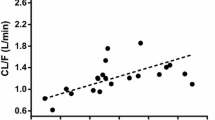Abstract
Background and Objective: Metformin is a biguanide used in the treatment of type 2 diabetes mellitus. In girls with a low birth weight, and early-normal and rapidly progressive puberty, metformin therapy is capable of modifying this outcome, prolonging pubertal growth, increasing height gain, delaying the age at menarche towards normal and improving the endocrine-metabolic status of these girls. The pharmacokinetics of metformin have been studied in healthy adults and in patients with type 2 diabetes. The objective of this study was to study the pharmacokinetics of metformin in young, non-obese girls.
Methods: The study population consisted of six girls with a combined history of low birth weight and early-normal onset of puberty. At the time of the study, these girls were aged 9 years and had been receiving metformin (850 mg/day at dinner time) for a mean duration of 8 months. Blood samples were obtained from the girls before metformin intake and for 12 hours thereafter. Serum metformin concentrations were assessed by liquid chromatography with tandem mass spectrometry. The area under the serum concentration-time curve (AUC), maximum serum concentration (Cmax), time to reach the Cmax (tmax), half-life (t½), volume of distribution (Vd) and total clearance (CL) were calculated.
Results: Metformin concentration-time curves were similar in girls receiving similar metformin doses (range 21–29 mg/kg): in those girls, the mean AUC was 21 mg · h/L, with a Cmax of 3 mg/L, tmax of 2.5 hours, t½ of 4 hours, Vd of 111 L and CL of 20 L/h. These values are comparable to those observed in adults.
Conclusion: In girls aged 9 years, the pharmacokinetics of metformin were comparable to those in adults.



Similar content being viewed by others
References
Nathan DM, Buse JB, Davidson MB, et al. Management of hyperglycemia in type 2 diabetes: a consensus algorithm for the initiation and adjustment of therapy. A consensus statement from the American Diabetes Association and the European Association for the Study of Diabetes. Diabetes Care 2006; 29: 1963–72
Brufani C, Fintini D, Nobili V, et al. Use of metformin in pediatric age. Pediatr Diabetes 2011; 12: 580–8
Ibáñez L, Ferrer A, Marcos MV, et al. Early puberty: rapid progression and reduced final height in girls with low birth weight. Pediatrics 2000; 106: E72
Ibáñez L, Valls C, Ong K, et al. Metformin therapy during puberty delays menarche, prolongs pubertal growth, and augments adult height: a randomized study in low-birthweight girls with early-normal onset of puberty. J Clin Endocrinol Metab 2006; 91: 2068–73
Ibáñez L, López-Bermejo A, Díaz M, et al. Early metformin therapy to delay menarche and augment height in girls with precocious pubarche. Fertil Steril 2011; 95: 727–30
Graham GG, Punt J, Arora M, et al. Clinical pharmacokinetics of metformin. Clin Pharmacokinet 2011; 50: 81–98
Gao X, Christensen M, Burghen GA, et al. Pharmacokinetics of metformin in pediatric type 2 diabetic and healthy adult subjects [abstract]. Clin Pharmacol Ther 2003; 73: P46
Pentikäinen PJ, Neuvonen PJ, Penttilä A. Pharmacokinetics of metformin after intravenous and oral administration to man. Eur J Clin Pharmacol 1979; 16: 195–202
Tzvetkov MV, Vormfelde SV, Balen D, et al. The effects of genetic polymorphisms in the organic cation transporters OCT1, OCT2, and OCT3 on the renal clearance of metformin. Clin Pharmacol Ther 2009; 86: 299–306
Chen Y, Teranishi K, Li S, et al. Genetic variants in multidrug and toxic compound extrusion-1, hMATE1, alter transport function. Pharmacogenomics J 2009; 9: 127–36
Salpeter SR, Greyber E, Pasternak GA, et al. Risk of fatal and nonfatal lactic acidosis with metformin use in type 2 diabetes mellitus. Cochrane Database Syst Rev 2010; (1): CD002967
Spiller HA, Weber JA, Winter ML, et al. Multicenter case series of pediatric metformin ingestion. Ann Pharmacother 2000; 34: 1385–8
Acknowledgements
David Sánchez-Infantes and Marta Díaz contributed equally to this work.
David Sánchez-Infantes is an investigator for the Fund for Scientific Research Sara Borrell, Instituto de Salud Carlos III (ISCIII) [Madrid, Spain]. Marta Díaz, María Victoria Marcos and Lourdes Ibáñez are clinical investigators for the Centro de Investigación Biomédica en Red de Diabetes y Enfermedades Metabólicas Asociadas (CIBERDEM), ISCIII [Madrid, Spain]. Abel López-Bermejo is an investigator for the Fund for Scientific Research I3, Ministry of Science & Innovation [Madrid, Spain]. Francis de Zegher is an investigator for the Clinical Research Fund, Leuven University Hospital [Leuven, Belgium].
The authors have no conflicts of interest to declare.
Author information
Authors and Affiliations
Corresponding author
Rights and permissions
About this article
Cite this article
Sánchez-Infantes, D., Díaz, M., López-Bermejo, A. et al. Pharmacokinetics of Metformin in Girls Aged 9 Years. Clin Pharmacokinet 50, 735–738 (2011). https://doi.org/10.2165/11593970-000000000-00000
Published:
Issue Date:
DOI: https://doi.org/10.2165/11593970-000000000-00000




